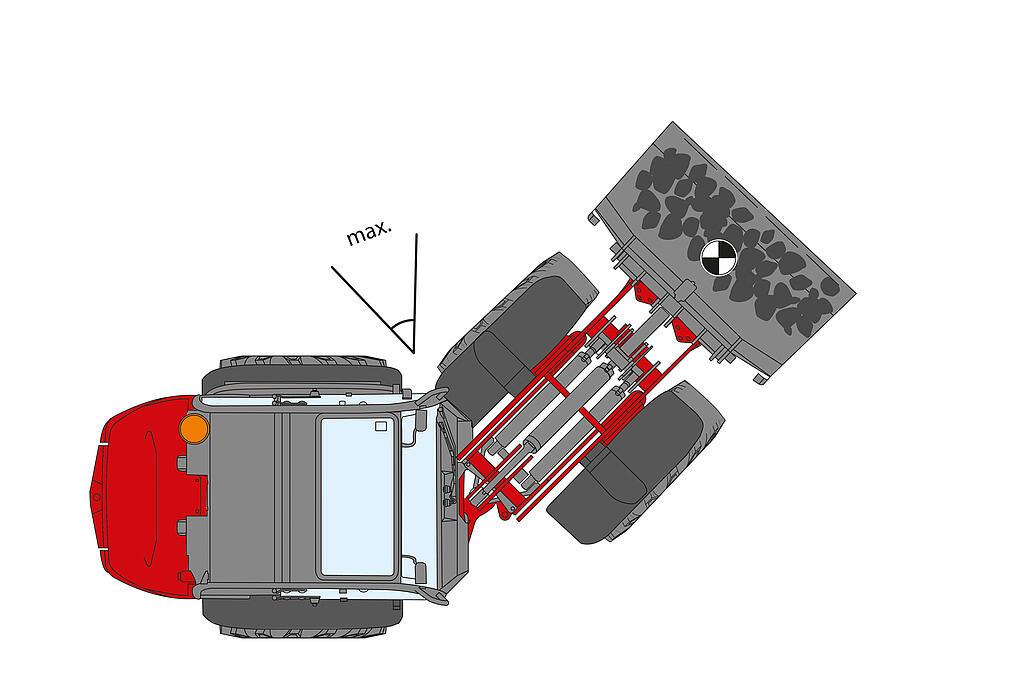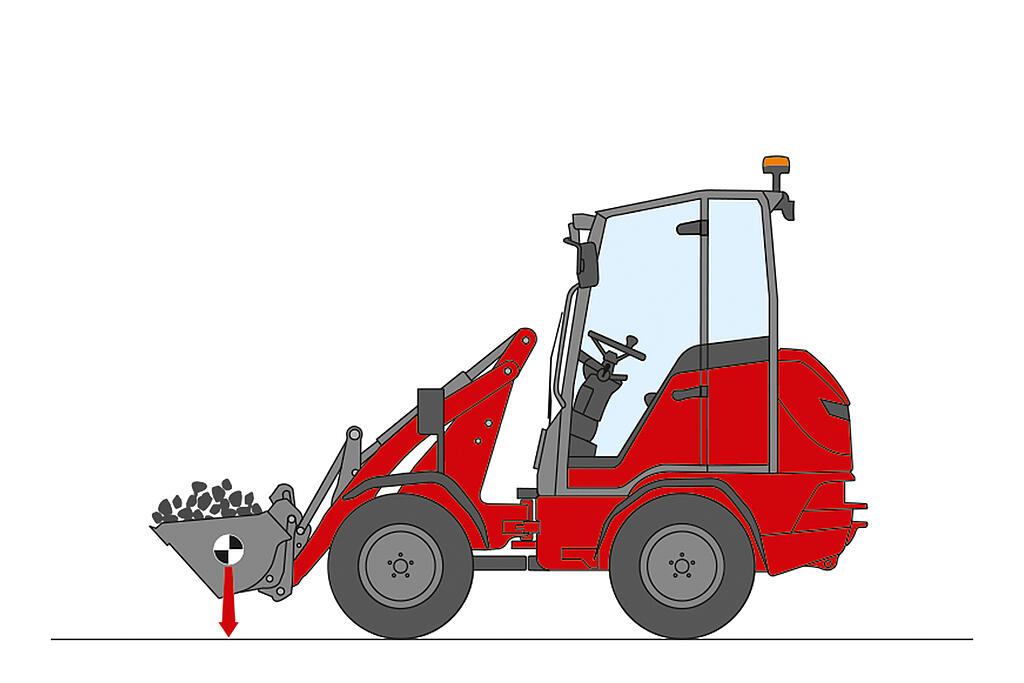| Battery technology | Lithium-ion |
| Battery voltage class | 48 V |
| Battery capacity | 14.1 kWh |
| Battery weight | 132 kg |
| On-board charging capacity (max.) | 3 kW |
| Loading time (0-100%) | 4 - 6* h |
| Loading time (20-80%) | 2,9* h |
| Running time up to | 3,27** h |
| Battery technology | Lithium-ion |
| Battery voltage class | 48 V |
| Battery capacity | 18.7 kWh |
| Battery weight | 148 kg |
| On-board charging capacity (max.) | 6 kW |
| Loading time (0-100%) | 3 - 8* h |
| Loading time (20-80%) | 1,9* h |
| Running time up to | 5,07** h |
| Battery technology | Lithium-ion |
| Battery voltage class | 48 V |
| Battery capacity | 23.4 kWh |
| Battery weight | 165 kg |
| On-board charging capacity (max.) | 6 kW |
| Loading time (0-100%) | 4 - 10* h |
| Loading time (20-80%) | 2,4* h |
| Running time up to | 7,30** h |
| Motor traction drive (EN60034-1) | 6,5 kW |
| Motor work hydraulics (EN60034-1) | 8.5 kW |
| Operating voltage | 12 V |
| Operating weight | 2,170 - 2,350 kg |
| Thrust force (max.) | 1,871 - 1,917 daN |
| Lift capacity (max.) | 1,778 - 1,811 daN |
| Tipping load with bucket – machine straight, loading frame horizontal | 1,320 - 1,680 kg |
| Tipping load with bucket – machine pivoted, loading frame horizontal | 1,090 - 1,360 kg |
| Tipping load with bucket - machine straight, loading frame in lowest position | 2,030 - 2,800 kg |
| Tipping load with bucket - machine pivoted, loading frame in lowest position | 1,690 - 2,280 kg |
| Tipping load with pallet fork – machine straight, loading frame horizontal | 1,000 - 1,210 kg |
| Tipping load with pallet fork – machine pivoted, loading frame horizontal | 820 - 970 kg |
| Tipping load with pallet fork - machine straight, transport position | 1,210 - 1,510 kg |
| Tipping load with pallet fork - machine pivoted, transport position | 1,000 - 1,210 kg |
| Driver's cab | FSD (eps, cabin) |
| Tank capacity for hydraulic oil | 20 l |
| Type of drive | Electrical |
| Drive unit | universal joint shaft |
| Speed levels | 1 |
| Axle | T80 |
| Travel speed Standard | 0-15 km/h |
| Operating brake | Drum brake acting on all four wheels |
| Parking brake | Electrical |
| Work hydraulics discharge volume (max.) | 32 l/min |
| Work hydraulics working pressure (max.) | 225 bar |
| Kinematics type | P |
| Lifting cylinder | 2 |
| Tipping cylinder | 1 |
| Quick change system | hydraulic |
| Steering type | hydraulically activated articulated pendulum steering |
| Steering cylinder | 1 |
| Oscillating angle | ± 12 degree |
| Average sound power level LwA (operator's canopy) | 85.1 dB(A) |
| Guaranteed sound power level LwA (operator's canopy) | 87 dB(A) |
| Specified sound pressure level LpA (operator's canopy) | 76 dB(A) |
| Average sound power level LwA (cabin) | 85.1 dB(A) |
| Guaranteed sound power level LwA (cabin) | 87 dB(A) |
| Specified sound pressure level LpA (cabin) | 75 dB(A) |
|
FSD = operator's canopy Tipping load calculation pursuant to ISO 14397
* The charging time is dependent on the different charging options. On-board battery charger 3 kW (standard) with additional on-board charger, total 6 kW (option). The following charging plug options are available: 230 V / 10 A Schuko, 230 V / 16 A CEE (blue, 3-pole), 400 V / 16 A CEE (red, three-phase, 5-pole), 400 V / 16 A (Type 2 plug Wallbox, IEC 62196) and other adapter plugs. ** The running times of the battery are dependent on the respective application conditions, the task and the driving style. This may also mean that a longer running time can be achieved. The specified running times may also be undercut in extreme cases. The specified running times refer to uninterrupted operation and working with the machine. |
When comparing tipping loads and lift capacities from different manufacturers, make sure that they have been determined in accordance with the ISO 14397-1 and 2 standards!
General Information
Attention: The tipping load changes depending on the various equipment features of a machine (e.g. operator’s platform/cab, rear weight, engine, tires, etc.). The net weight of the various attachments naturally also plays a role here.
Important to note
Good to know: Tipping loads determined in the buckled state are highly dependent on the buckling angle of the machine. Weidemann determines these values in the fully folded state. When comparing with other manufacturers, please note the kink angle used!
When comparing tipping loads and lift capacities from different manufacturers, make sure that they have been determined in accordance with the ISO 14397-1 and 2 standards!
General Information
Attention: The tipping load changes depending on the various equipment features of a machine (e.g. operator’s platform/cab, rear weight, engine, tires, etc.). The net weight of the various attachments naturally also plays a role here.
Important to note
Good to know: Tipping loads determined in the buckled state are highly dependent on the buckling angle of the machine. Weidemann determines these values in the fully folded state. When comparing with other manufacturers, please note the kink angle used!

|
|
The maximum lift capacity in the bucket’s center of gravity is measured by Weidemann as follows:

|
|
The maximum tear out force on the below bucket edge is measured by Weidemann according to the standard ISO 14397-2, this means:

|
|
The maximum load weight of a machine is known as the tipping load. This is achieved when the rear wheels of the machine lose contact with the ground. The tipping load is measured by Weidemann according to the standard ISO 14397-1, this means:


|
|
The maximum load weight of a machine is known as the tipping load. This is achieved when the rear wheels of the machine lose contact with the ground. The tipping load in lowest position is measured by Weidemann as follows:


|
|
The maximum load weight of a machine is known as the tipping load. This is achieved when the rear wheels of the machine lose contact with the ground. The tipping load is measured by Weidemann according to the standard ISO 14397-1, this means:


|
|
The maximum load weight of a machine is known as the tipping load. This is achieved when the rear wheels of the machine lose contact with the ground. The tipping load in transport position is measured by Weidemann as follows:


|
When the loader is used in accordance with the intended purpose, the whole body vibrations vary from below 0.5 m/s² up to a short-term maximum value.
It is recommended to use the values specified in the table when calculating the vibration values according to ISO/TR 25398:2006. In doing so, the actual application conditions are to be taken into consideration.
Telehandlers, like wheel loaders, are to be classified by operating weight.
Hand-arm vibrations: The hand-arm vibrations are no more than 2.5 m/s²
Whole-body vibrations: This machine is equipped with an operator’s seat that meets the requirements of EN ISO 7096:2000.
| Type of loader | Typical operating conditions | Mean value [m/s2] | Standard deviation (s) in [m/s2] | ||||||
|
| ||||||||
| Compact wheel loader (operating weight < 4500 kg) | Load & carry (load and transport work) |
|
| ||||||
| Wheel loader (operating weight > 4500 kg) | Load & carry (load and transport work) |
|
| ||||||
| Application in extraction (harsh application conditions) |
|
| |||||||
| Delivery drive |
|
| |||||||
| V-operation |
|
|